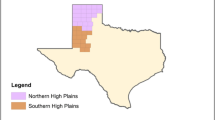Abstract
Traditional economic analysis using a crop production function approachhas assumed that all variable factors, including irrigation water, arefully employed in the crop production process. However, this paper firstdemonstrates that economic benefits of irrigation water areoverestimated when the crop production function, and therefore theirrigation water demand function, is expressed in terms of irrigationwater supplied, rather than consumptive irrigation water use. Second,the paper demonstrates that the magnitude of the estimation bias isproportional to the rate of irrigation water losses through leaching,runoff and evaporation. Consequently, the model misspecification problemwould lead to increased irrigation water use and reduce incentives forfarmers to adopt improved irrigation technologies.
Similar content being viewed by others
References
Caswell, M. and D. Zilberman (1986), ‘The Effects of Well Depth and Land Quality on the Choice of Irrigation Technology’, American Journal of Agricultural Economics 68, 798-980.
Feinerman, E. (1988), ‘Groundwater Management: Efficiency and Equity Considerations’, Agricultural Economics 2, 1-18.
Feinerman, E. and K. Knapp (1983), ‘Benefits from Groundwater Management: Magnitude, Sensitivity, and Distribution’, American Journal of Agricultural Economics 65, 703-710.
Fleming, R. A., R. M. Adams and C. S. Kim (1995), ‘Regulating Groundwater Pollution: Effects of Geophysical Response Assumptions on Economic Efficiency’, Water Resources Research 31, 1069-1076.
Gisser, M. (1983), ‘Groundwater: Focusing on the Real Issues’, Journal of Political Economics 91, 1001-1027.
Gisser, M. and R. J. Johnson (1983), ‘Institutional Restrictions on the Transfer of Water Rights and the Survival of An Agency’, in T. Anderson, ed., Water Rights: Scarce Resource Allocation, Bureaucracy, and the Environment, pp. 137-165.
Gisser, M. and D. A. Sanchez (1980), ‘Competition Versus Optimal Control in Groundwater Pumping’, Water Resources Research 16(4), 638-642.
Huffman, W. E. and R. E. Evanson (1989), ‘Supply and Demand Functions for Multiproduct U.S. Cash Grain Farms: Biases Caused by Research and Other Policies’, American Journal of Agricultural Economics 71(3), 761-773.
Just, R. E. and D. L. Hueth (1979), ‘Welfare Measures in a Multimarket Framework’, American Economic Review 69, 947-954.
Kim, C. S. and N. Gollehon (1995), ‘Costs to Farmers of Complying with Drinking Water Standards: A Case Study of Irrigated Agriculture in Nebraska’, Working Paper, Economic Research Service, USDA.
Kim, C. S., J. E. Hostetler and G. Amacher (1993), ‘The Regulation of Groundwater Quality with Delayed Responses’, Water Resources Research 29(5), 1369-1377.
Kim, C. S., M. R. Moor, J. Hanchar and M. Nieswiadomy (1989), ‘A Dynamic Model of Adaptation to Resource Depletion: Theory and An Application to Groundwater Mining’, Journal of Environmental Economics and Management 17, 66-82.
Kim, C. S., C. L. Sandretto, R. A. Fleming and R. M. Adams (1997a), ‘An Alternative Specification for Modeling Groundwater Dynamics’, Natural Resource Modeling 10(3), 173-183.
Kim, C. S., C. L. Sandretto and J. E. Hostetler (1996), ‘Effects of Farmers Response to Nitrogen Fertilizer Management Practices on Groundwater Quality’, Water Resources Research 32(5), 1411-1415.
Kim, C. S., C. L. Sandretto and N. D. Uri (1997b), ‘The Implications of the Adoption of Alternative Production Practices on the Estimation of Input Productivity in Agriculture’, Energy and Environment 8(2), 133-150.
Knapp, K. C. (1983), ‘Steady-State Solutions to Dynamic Optimization Models with Inequality Constraints’, Land Economics 59, 300-304.
Nieswiadomy, M. (1985), ‘The Demand for Irrigation Water in the High Plains of Texas, 1957–1980’, American Journal of Agricultural Economics 67, 619-626.
Shumway, C. R. (1983), ‘Supply, Demand, and Technology in a Multiproduct Industry: Texas Field Crops’, American Journal of Agricultural Economics 65, 748-760.
Vroomen, H. and H. Taylor (1992), ‘Fertilizer Use and Price Statistics, 1960–91’, Statistical Bulletin No. 842, Economic Research Service, USDA.
Williams, J., L. Reed, F. Lamm and D. Delano (May 1997), Economic Analysis of Alternative Irrigation Systems for Continuous Corn and Grain Sorghum in Western Kansas. Contribution No. 96-473-S, The Kansas Agricultural Experimental Station.
Wu, J., H. P. Mapp and D. J. Bernardo (1994), ‘A Dynamic Analysis of the Impact of Water Quality Policies on Irrigation Investment and Crop Choice Decisions’, Journal of Agricultural and Applied Economics 26, 506-525.
Author information
Authors and Affiliations
Rights and permissions
About this article
Cite this article
Kim, C., Schaible, G.D. Economic Benefits Resulting From Irrigation Water Use: Theory and an Application to Groundwater Use. Environmental and Resource Economics 17, 73–87 (2000). https://doi.org/10.1023/A:1008340504971
Issue Date:
DOI: https://doi.org/10.1023/A:1008340504971




